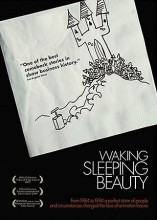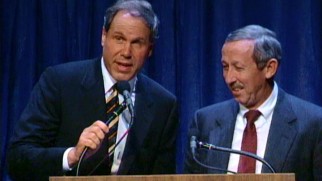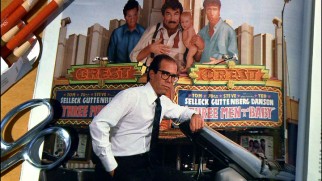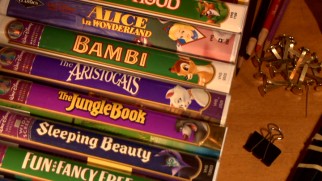Waking Sleeping Beauty DVD Review
 | Waking Sleeping Beauty ranks 56th in our list of the Top 100 Movies of the Half-Decade (2010-2014). |
Buy Waking Sleeping Beauty from Amazon.com: DVD • Instant Video
Waking Sleeping Beauty is kind of an odd title for the documentary it's attached to. For Disney fans, it immediately conjures the image of the 1959 Technirama fairy tale, but that is not one of the handful of 1980s and 1990s animated films from the studio whose creation and creators are celebrated here. Even if you're familiar enough with Disney chronology to recognize the title's intent, you may question it, because the animation renaissance that marked Michael Eisner's reign did not have to look all the way back to Aurora, Maleficent and company for a model of excellence. Who today doubts the worthiness of films like 101 Dalmatians, The Jungle Book, and The Many Adventures of Winnie the Pooh? Waking Sleeping Beauty possesses a general interest in animated filmmaking, a form whose perceived artistic, commercial, and critical value has oscillated over the years. The medium made a grand American debut with Snow White and the Seven Dwarfs, the 1937 film dubbed Disney's Folly during production that would sell a number of tickets unheard of today even with the world's population tripled. Triumphs -- creatively if not initially financially -- followed, like Pinocchio, Fantasia, and Bambi, but then World War II hit and took Walt and his studio away from their calling. When they returned, with 1950's hit Cinderella, Walt had moved his sights to the next big thing, the theme park that would be called Disneyland. While charming and endearing, the decade's plentiful output (including Alice in Wonderland, Peter Pan, and Lady and the Tramp) is considered on a different plane. As to some degree are Disney's subsequent efforts, from Sleeping Beauty and the winning Jungle Book to popular works of the so-called "Dark Age" such as Robin Hood, The Rescuers and The Fox and the Hound.
Hahn's documentary looks at the boom that came next, one that brought him and other revered figures to Disney's fray, including Pixar guru John Lasseter, visionary director Tim Burton, and the accomplished duo of Ron Clements and John Musker. Such artists were part of the exciting atmosphere surrounding Disney's changing of the guard. In 1984, Frank Wells, Michael Eisner, and Jeffrey Katzenberg came on board as president, CEO, and chairman, respectively, each put in power by Roy E. Disney, who had resigned amidst vocal disenchantment only to return with new determination to preserve the company founded by his father and uncle decades earlier.
Afforded some distance, the rise and fall of the animation division has meaning and impact, particularly as relayed here. Waking doesn't disparage the efforts immediately predating the focal 1984-1994 period, merely establishing 1985 release The Black Cauldron as a costly, contentious flop that would be easy to best. Many welcomed that challenge, including inexperienced animation president Peter Schneider (who co-produced Waking with Hahn).
Aware that there are far too many factors and variables to guarantee success, the documentary doesn't try to theorize what made movies like The Little Mermaid, Beauty and the Beast, Aladdin, and The Lion King so widely embraced and beloved. Instead, it shares with us their creative processes, from storytelling challenges to the workplace interactions that addressed them. Waking seems more interested in the latter, delving into the management manners and opposite perspectives. The four aforementioned films, dubbed the "Big Four" by Disney fans of a certain age, are given the most attention, with notice paid to their setbacks and accomplishments alike.
Other films from the era are also considered. The biggest point made regarding The Great Mouse Detective is the title revision from Basil of Baker Street, a dispute that inspired an anonymous memo that inspired a "Jeopardy!" category. Oliver & Company is mentioned, less from a critical view than a factual one. The Rescuers Down Under is discussed as the first showcase of Disney's costly CAPS digital ink and paint system and as a demonstration of Katzenberg's decisive techniques (he pulled advertising after an underwhelming debut). The Steven Spielberg-produced Who Framed Roger Rabbit and Burton's The Nightmare Before Christmas are treated like the one-offs Above all else, Waking Sleeping Beauty gives us a sense of what it was like to work in Disney animation during this productive period that gave birth to treasured films that will be enjoyed long after their makers have passed. That fact is acknowledged in touching segments covering the premature deaths of AIDS-stricken lyricist Howard Ashman and humble peacemaker Wells, on whose exit the film concludes.
Hahn and Schneider have come up with a very creative way to combat a commonplace limitation of the documentary film. They avoid new talking heads altogether. Though nearly twenty relevant individuals reflect on their experiences, including now rival DreamWorks Animation CEO Katzenberg, succeeded Eisner, and the late Roy E. Disney, their comments are laid over footage from the documented era. That footage includes a lot of candid home movies at the studio (most notably a 1980 tour hosted by animator Randy Cartwright and shot by Lasseter) and a fitting amount of clips from the movies. That would have been an understandable main course, but Waking Sleeping Beauty goes further, providing scenes from press conferences, corporate videos, voice recording sessions, news reports, test screenings, and staff events, along with many photos and illustrations. The filmmakers don't even stop there, making sure to clear pertinent video from other sources, like animated competition The Land Before Time and The Care Bears Movie, the Academy Awards, Siskel and Ebert's reviews, and, for good reason, "The Munsters."
There is a gentle sense of humor to the film (such as when The Silence of the Lambs' Best Picture win is shown against expectations) and more noticeable than that, a winning attitude and perspective. Hahn's movie doesn't overstate Disney's achievements or failings. You never question his motives, even as he revisits his own greatest hits with detectable pride and slight disproportionality. He avoids the temptation to choose a scapegoat, while not shying from the turmoil arising from Katzenberg, Eisner, and Roy Disney's ego and credit issues, even pinpointing it to specific incidents.
While I must confess that the subject matter and era is of much greater interest to me than the average individual, I have a tough time believing that anyone won't be riveted by this very human approach to very compelling material. That Disney, known for their happiest place on earth image and historical revisionism, would fund this frank and thorough look at its recent self is inspiring, particularly when a movie like this seems to have no business existing in their present tentpole/franchise filmmaking philosophy.
Of course, a tiny documentary like Waking Sleeping Beauty has minimal effect on Disney's bottom line. The film has been shown in at least nine film festivals beginning with Telluride in September 2009. It received a general theatrical release in the United States last March, making $80,741 in a grand total of five theaters. I believe that qualifies it for Academy Award consideration, although it didn't make the Best Documentary Feature shortlist issued earlier this month. And why would it? As involving and exquisitely executed as it is, how could a Disney movie about Disney movies compete with spicy subject matter like education, Iraq, and Elliot Spitzer?
At least Disney has seen fit to make Waking available to the general public. It releases the film today exclusively on DVD alongside fellow recent Disney-on-Disney documentaries Walt & El Grupo and The Boys: The Sherman Brothers' Story.
VIDEO and AUDIO
Waking Sleeping Beauty is presented in 1.78:1 anamorphic widescreen and it maintains that aspect ratio for the majority of its feature runtime (matting where appropriate). Its video is assembled from a wide variety of sources and this shows in the appropriately inconsistent picture quality. Some clips look better than others, but none look as bad as you might expect them to. Sure, the Cartwright/Lasseter studio tour isn't the clearest or most vibrant, but how could they have known their recording would be mesmerizing the general public thirty years later? For the most part, the video exhibits satisfactory cleanness and sharpness. The rare instances when it doesn't (like a clip of Connie Chung's "CBS Evening News") are clearly no fault of either the filmmakers or the DVD producers.
Similarly, the Dolby Digital 5.1 soundtrack is largely limited to the clips rounded up, but it doesn't disappoint. The old footage has surprisingly good sound recordings and in the rare moments when it might be less than intelligible, the film has burned-in subtitles translate. The movie makes nice use of Disney music, not only from the Broadway-style Eisner renaissance works, but also older scores like 20,000 Leagues Under the Sea and Mary Poppins to complement brief mentions. The film's powerhouse closing sequence takes the mix to effective heights. Even in the more unremarkable stretches that preceded it, there is a pleasant void of distortion, inconsistency, and age to the materials.
BONUS FEATURES, MENUS and PACKAGING
A healthy supply of bonus features begins with the making-of featurette "Why Wake Sleeping Beauty?" (8:52). Don Hahn and Peter Schneider explain their intentions on the project and their experiences, Six items listed as deleted scenes (running 33:47 overall) cover inessential but highly interesting ground. A couple of these offer extended views of footage sampled in the film: Howard Ashman's lecture on music in animated and live-action films (12:33) and Jodi Benson recording "Part of Your World" with Ashman coaching her (6:30). The other completely discarded bits are edited and prepared for film use: Aladdin's Good Friday reset (echoing the Beauty and the Beast experience) and concerns of the Gulf War's effect on production (4:40); more on losing Howard Ashman (4:54) with comments from his sister Sarah Gillespie and companion Bill Lauch; bits on Feature Animation research trips (4:20) to Australia (The Rescuers Down Under), France (Beauty and the Beast), and Africa (The Lion King); and Jeffrey Katzenberg's To Sir, with Love-like goodbye party (1:40) with photos and memories.
"The Sailor, The Mountain Climber, The Artist & The Poet" (15:25) discusses the four late featured individuals to whom the film is dedicated: Roy Disney, Frank Wells, Joe Ranft, and Howard Ashman. Each man is discussed by the speakers of the other featurette.
"The Disney Studio Tours" shows us more of the three documentaries excerpted in the feature. Randy Cartwright enthusiastically leads the tours, learning about current projects from employees like Glen Keane, mopey Tim Burton, Joe Ranft, Eric Larson, Ron Clements, and John Musker. John Lasseter shoots the first (4:54), made in 1980, and second (4:16), done in 1983 as Cartwright's farewell before moving to Japan to make Little Nemo: Adventures in Slumberland. The third (4:25) is a 10th anniversary (to the hour!) tour shot on 1990 video technology. This footage is simply amazing and full of foresight and humor. Cartwright explains the tours in a new 55-second introduction.
"A Reunion" (2:12) briefly reunites directors Kirk Wise (Beauty and the Beast) and Rob Minkoff (The Lion King) to talk about their over 30-year friendship and their histories at Disney and before.
"Walt" (6:00) discusses the company namesake, his life's work upon which the Renaissance was built, and what he would think of the movie. It makes up for his lack of celebration in the film itself and thankfully isn't sanctimonious.
The on-disc extras conclude with an audio commentary by director Don Hahn and producer Peter Schneider. They also include outtakes from those interviewed for the film, including the late Roy Disney, on topics related to what's on screen. Glen Keane talks The Rescuers Down Under, an otherwise unheard Andreas Deja recalls Roger Rabbit, and so on. The DVD opens with trailers for The Boys: The Sherman Brothers' Story and Walt & El Grupo. Waking Sleeping Beauty's own trailer is missed. The menu's Sneak Peeks listing plays promos for Disneynature's African Cats, Fantasia & Fantasia 2000: 2 Movie Collection, the D23 fan community, Bambi: Diamond Edition, and The Lion King: Diamond Edition.
The nice main menu montage offers blue-tinted views of Disney studio locations. Submenus give us differently-scored static variations on the theme.
The packaging of Waking Sleeping Beauty deliberately avoids Disney branding, bearing the rarely-used Buena Vista Home Entertainment label and only barely. A sticker on the front of the obligatory slipcover mentions that the release includes a special collectible. Not unlike the in-pack offerings of the Walt Disney Treasures line (which this week's niche fan-friendly releases seem to replace), it is a lithograph. The matte-finished postcard quality print features Kirk Wise's colored drawing of Howard Ashman "excoriating" him and to a lesser extent co-director Gary Trousdale in a Beauty and the Beast story meeting, a comic illustration seen in the movie. It is joined by a Disney Movie Rewards code and Disney's dated adult-oriented Blu-ray promotional booklet.
CLOSING THOUGHTS
Waking Sleeping Beauty is something that anyone with an appreciation for the animated Disney movies of the late 1980s and early 1990s should see. Don Hahn's documentary is a wonderful trip down memory lane, supplying an accessible behind-the-scenes look at the making of films destined to be enjoyed for as long as any of their live-action contemporaries. Boasting a great feature presentation and an extensive collection of valuable bonus features, this welcome DVD is a treat and an ideal gift idea for a Disney fan. While the subject may hit closest to home for those now in their twenties and thirties, film enthusiasts of any age should be able to heartily enjoy this highly recommended set.
Buy Waking Sleeping Beauty from Amazon.com: DVD / Instant Video
|
Related Reviews:
Related Interviews: Don Hahn • Andreas Deja • Don Hahn & Ilene Woods • Dave Bossert
DVDizzy.com | Disney Documentaries | Disney Animated Classics | DVD & Blu-ray Reviews | Release Schedule | Upcoming Cover Art | Search This Site
DVDizzy.com Top Stories:
New: The Sorcerer's Apprentice • Scott Pilgrim vs. the World • Avatar (Extended Collector's Edition) • The Search for Santa Paws • A Christmas Carol
1984-1994 Disney: Beauty and the Beast (Blu-ray) • The Little Mermaid • The Lion King • Aladdin • Oliver & Company • The Nightmare Before Christmas
Dream On Silly Dreamer • Walt: The Man Behind the Myth • The Hand Behind the Mouse: The Ub Iwerks Story • Disneyland: Secrets, Stories & Magic
Walt Disney Treasures: Behind the Scenes at the Disney Studio • Hearts of Darkness: A Filmmaker's Apocalypse • The Pixar Story
Henson's Place: The Man Behind the Muppets • Oceans • America's Heart & Soul • The Crimson Wing • Earth
2010 Stone Circle Pictures, Red Shoe Productions, Walt Disney Studio Motion Pictures, and Buena Vista Home Entertainment.

















